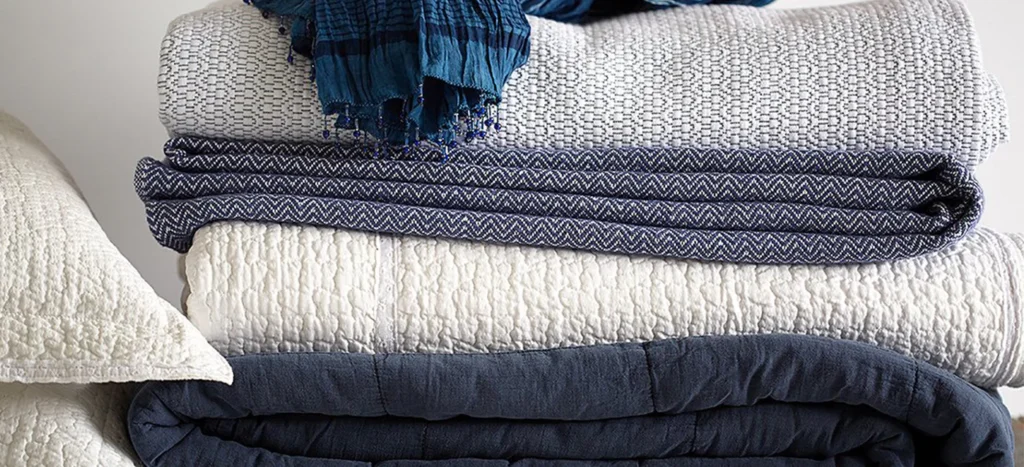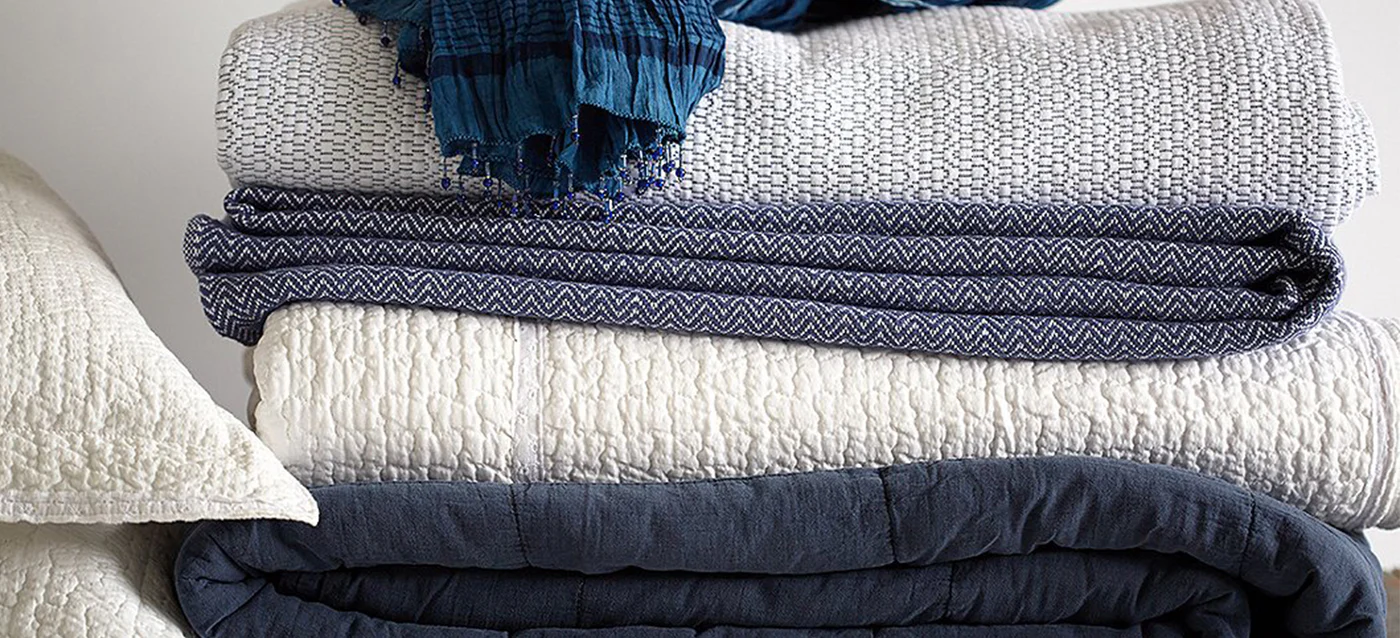
Blankets are essential for comfort, warmth, and style in any home. From cozy winter nights to breezy summer evenings, the right blanket can enhance your sleep, elevate your decor, and suit various seasons and purposes. This guide explores 10 types of blankets, their materials, key features, and ideal uses, helping Canadian homeowners (and others) choose the perfect option for their needs in 2025. Drawing from expert insights and market trends, we’ve curated a list that balances functionality, aesthetics, and versatility.
1. Comforter
Best for Cold Winters
- Material: Cotton, polyester, or microfiber shell with down, feathers, cotton, or synthetic polyfill filling
- Key Features: Thick, quilted, fluffy; often paired with duvet covers; available in various warmth levels
- Ideal Use: Bedroom bedding for cold climates
- Price Range (CAD): $50–$300
Comforters are a staple in colder regions like Canada, offering substantial warmth due to their thick, insulated filling. They consist of a top and bottom fabric layer with a middle layer of insulating material, stitched together to prevent shifting. Their fluffy, cloud-like appearance adds visual appeal to bedrooms, and they can be used alone or with a duvet cover for easy cleaning.
Pros:
- Excellent warmth for winter
- Decorative, available in various patterns and colors
- Lightweight options available for milder climates
Cons:
- Some require dry cleaning (especially down-filled)
- Too warm for hot sleepers or summer use
2. Duvet
Best for Versatility
- Material: Down, feathers, or synthetic filling with a cotton or polyester cover
- Key Features: Requires a removable duvet cover; highly insulating; easy to wash cover
- Ideal Use: Year-round bedroom use with seasonal cover changes
- Price Range (CAD): $80–$400 (insert + cover)
Duvets are similar to comforters but designed to be used with a removable cover, acting like a pillowcase for the blanket. This makes them versatile, as you can swap covers to match decor or season. They’re ideal for Canadians who want a warm yet customizable bedding option, with covers that are easy to wash.
Pros:
- Easy to clean with removable cover
- Customizable style with different covers
- Warm and cozy for winter
Cons:
- Insert and cover can shift if not secured properly
- Higher upfront cost with cover purchase
3. Quilt
Best for Lightweight Bedding
- Material: Cotton or cotton-blend with thin batting (cotton, polyester, or wool)
- Key Features: Thin, breathable, hand- or machine-stitched with decorative patterns
- Ideal Use: Spring/summer bedding or layering in winter
- Price Range (CAD): $60–$250
Quilts are thinner than comforters, featuring a sandwich of fabric, batting, and a decorative top layer. Often handmade or heirloom-quality, they’re prized for their nostalgic charm and breathability, making them perfect for milder Canadian seasons or layering in winter.
Pros:
- Lightweight and breathable
- Easy to launder
- Adds a cozy, vintage aesthetic
Cons:
- Less warm than comforters or duvets
- Cotton quilts may shrink if not washed carefully
4. Throw Blanket
Best for Decor and Light Warmth
- Material: Cotton, fleece, acrylic, or wool; single-layer or lightly quilted
- Key Features: Smaller (around 50” x 60”), decorative, often with fringe or texture
- Ideal Use: Living room sofas, chairs, or as an accent piece
- Price Range (CAD): $20–$100
Throw blankets are smaller, designed for style and light warmth. They’re perfect for draping over a sofa or chair, adding texture and color to Canadian living spaces. They’re less suited for full-bed coverage but great for cozying up while reading or watching TV.
Pros:
- Stylish and versatile for decor
- Affordable and easy to store
- Lightweight for casual use
Cons:
- Too small for full bedding
- Limited warmth for cold nights
5. Bamboo Blanket
Best for Eco-Conscious Homes
- Material: Bamboo rayon or viscose
- Key Features: Ultra-soft, breathable, hypoallergenic, moisture-wicking
- Ideal Use: Year-round bedding, especially for hot sleepers or sensitive skin
- Price Range (CAD): $70–$200
Bamboo blankets, often made from bamboo-derived rayon, are soft, sustainable, and ideal for eco-conscious Canadians. Their breathability and moisture-wicking properties make them perfect for warm summers or hot sleepers, while their hypoallergenic nature suits allergy sufferers.
Pros:
- Eco-friendly and sustainable
- Soft, silky feel
- Great for sensitive skin
Cons:
- Less warm than down or wool
- May be pricier than cotton options
6. Wool Blanket
Best for Heavy Winter Warmth
- Material: Sheep’s wool, cashmere, or alpaca
- Key Features: Highly insulating, moisture-wicking, naturally odor-resistant
- Ideal Use: Winter bedding or outdoor use in cold climates
- Price Range (CAD): $100–$400
Wool blankets, including luxurious cashmere or alpaca varieties, are exceptionally warm and perfect for Canada’s harsh winters. They regulate temperature and wick moisture, keeping you dry and cozy. Their durability makes them suitable for both indoor and outdoor use.
Pros:
- Extremely warm and durable
- Naturally regulates temperature
- Hypoallergenic (especially alpaca)
Cons:
- Can feel heavy or scratchy
- Expensive, especially cashmere
7. Fleece Blanket
Best for Budget-Friendly Warmth
- Material: Polyester fleece
- Key Features: Soft, lightweight, quick-drying, warm
- Ideal Use: Casual use in living rooms, camping, or kids’ rooms
- Price Range (CAD): $20–$80
Fleece blankets are synthetic, affordable, and cozy, offering warmth without the weight of wool. They’re a go-to for Canadian families, perfect for snuggling on the couch or outdoor adventures due to their quick-drying nature.
Pros:
- Affordable and widely available
- Lightweight and warm
- Easy to wash and dry
Cons:
- Less breathable than natural fibers
- Prone to pilling over time
8. Sherpa Blanket
Best for Plush Comfort
- Material: Polyester with faux-sheepskin pile
- Key Features: Extra fluffy, warm, soft like lambswool
- Ideal Use: Winter bedding or cozy living room throws
- Price Range (CAD): $40–$120
Sherpa blankets mimic the feel of sheepskin with a thick, fluffy pile, making them incredibly cozy for cold Canadian nights. They’re popular as both bedding and decorative throws, adding a luxurious texture to any space.
Pros:
- Super soft and warm
- Budget-friendly compared to wool
- Durable and machine-washable
Cons:
- Can be too warm for summer
- May shed initially
9. Weighted Blanket
Best for Calming Sleep
- Material: Cotton or polyester with glass beads or plastic pellets
- Key Features: Heavy (10–30 lbs), promotes relaxation, reduces anxiety
- Ideal Use: Bedroom for restless sleepers or those with anxiety
- Price Range (CAD): $80–$250
Weighted blankets provide gentle pressure to promote relaxation, making them ideal for Canadians seeking better sleep or stress relief. They’re filled with beads and come in various weights, typically 10–20% of your body weight.
Pros:
- Calming and sleep-enhancing
- Available in various weights
- Often hypoallergenic
Cons:
- Heavy and not ideal for hot sleepers
- Can be difficult to clean
10. Electric Blanket
Best for Customizable Warmth
- Material: Polyester or microfiber with internal heating wires
- Key Features: Adjustable heat settings, auto shut-off, warm
- Ideal Use: Winter bedding or living room use in cold climates
- Price Range (CAD): $60–$200
Electric blankets are perfect for Canada’s frigid winters, offering adjustable heat settings for personalized warmth. They’re energy-efficient and often include safety features like auto shut-off, making them a practical choice for cozy nights.
Pros:
- Customizable warmth
- Energy-efficient alternative to heating
- Soft and comfortable
Cons:
- Requires power source
- Not suitable for machine washing
Choosing the Right Blanket for Your Home
When selecting a blanket, consider the following:
- Climate: For Canada’s cold winters, opt for comforters, duvets, wool, or electric blankets. For milder seasons, choose bamboo, cotton, or quilts.
- Purpose: Bedding (comforters, duvets, quilts), decor (throws), or specialty (weighted, electric).
- Material: Natural fibers (cotton, bamboo, wool) are breathable and hypoallergenic; synthetics (fleece, Sherpa) are affordable and durable.
- Care: Check if the blanket is machine-washable or requires dry cleaning (e.g., down comforters).
- Budget: Throws and fleece are budget-friendly, while wool and down are pricier.
- Aesthetic: Match colors and textures to your decor, especially for throws and quilts.
Care Tips for Blankets
- Washing: Machine-wash cotton, fleece, and Sherpa blankets on a gentle cycle. Dry clean or professionally wash down and wool blankets.
- Storage: Store in breathable cotton bags in a dry, ventilated area to prevent mold. Avoid compressing weighted or down blankets.
- Maintenance: Fluff comforters and duvets daily to maintain loft. Spot-clean stains on delicate materials like silk or cashmere.
